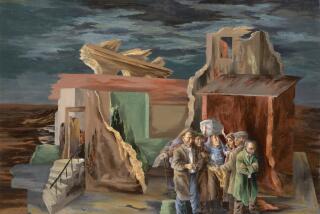World’s Highest-Paid Living Artist : Olaf Wieghorst; Painted American West
- Share via
SAN DIEGO — Olaf Wieghorst, one of this century’s leading if not most prominent Western artists whose work once hung in the Oval Office of the White House, died Wednesday after lapsing into a coma at an East San Diego County hospital. He was 88.
A spokeswoman at Grossmont Hospital declined to release the cause of death. But a longtime friend of the artist said that Wieghorst’s health took a turn for the worse after a horseback riding accident in October.
The incident was a sad irony for a man who prided himself on his equestrian prowess and credited horses with teaching him to paint.
“My greatest teacher has been the horse,” Wieghorst told The Times in a 1982 interview.
‘Paint What I Know’
“I couldn’t have learned what I did from some teacher in art school,” he said. “I learned about horses by sleeping, freezing, thirsting and starving with them. I learned by doing; I paint what I know.”
A former cavalry soldier and cowboy, Wieghorst painted the American West so well that many art experts saw him as this century’s answer to Frederic Remington, who died in 1909.
Troy Murray, whose Scottsdale, Ariz., gallery sold many of Wieghorst’s pieces, said the artist’s oil paintings fetch an average of $250,000, while a watercolor would go for about $12,500.
In 1982, a Wieghorst painting entitled “Navajo Madonna” was purchased for $450,000 and then resold with another piece called “Navajo Man” for $1 million. Not only were those prices the highest ever for Western art, they made Wieghorst the highest-paid living artist in the world, Murray said.
Wieghorst’s artwork has been in the collection of three U.S. Presidents--Dwight D. Eisenhower, Gerald R. Ford and Ronald Reagan--and a host of other prominent Americans, including Sen. Barry Goldwater, Clint Eastwood, Burt Reynolds and tire magnate Leonard Firestone. Eisenhower put a Wieghorst painting on a wall of the Oval Office during his eight years in office.
Worked From Memory
Murray said Wieghorst never worked from pictures but had a remarkable photographic memory that allowed him to size up landscapes and scenes and then retreat to his El Cajon studio to reproduce them on canvas.
Wieghorst was prolific, producing an estimated 3,000 paintings and sculptures, Murray said. A generous man, Wieghorst once give an airplane flight attendant a sketch worth $3,000 just for good beverage service, Murray said.
That generosity lasted until the final hours of his life.
Earlier Wednesday, Wieghorst made sure the nursing staff all received signed lithographs. He lapsed into a coma shortly after.
The son of a Danish photographer, he came to America in 1919 after signing on as a seaman on a Danish merchant ship. He jumped ship in Hoboken, N.J., and later joined the U.S. Cavalry, where he helped chase Pancho Villa.
Granted American citizenship through his cavalry service, Wieghorst embarked on a varied career that included work as a cowboy for three years in New Mexico and then as a mounted policeman in New York City. In his spare time, he began sketching horses.
He took up painting full time when he quit the police force in 1944 and moved his family to El Cajon, about 15 miles east of San Diego.
Wieghorst is survived by his wife, Mae, and a son, Ray.
More to Read
The biggest entertainment stories
Get our big stories about Hollywood, film, television, music, arts, culture and more right in your inbox as soon as they publish.
You may occasionally receive promotional content from the Los Angeles Times.










